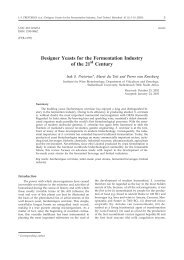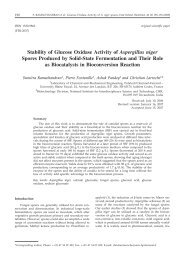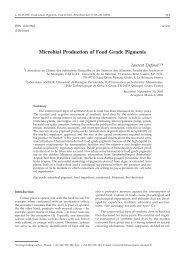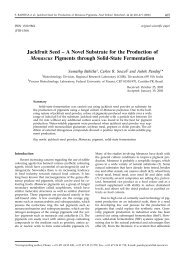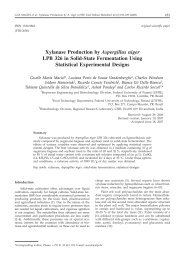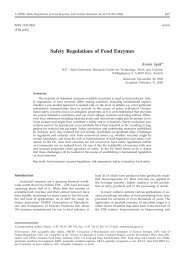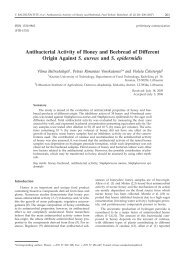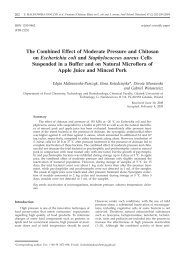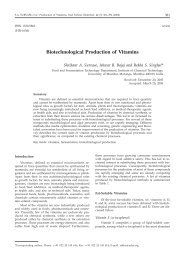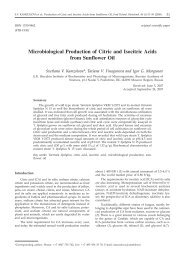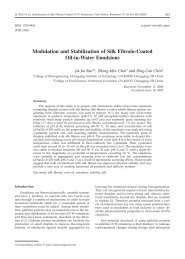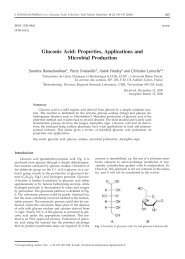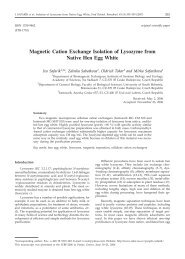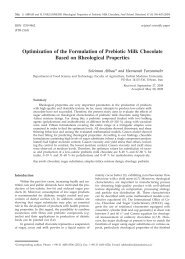Influence of Saccharomyces uvarum on Volatile Acidity, Aromatic ...
Influence of Saccharomyces uvarum on Volatile Acidity, Aromatic ...
Influence of Saccharomyces uvarum on Volatile Acidity, Aromatic ...
You also want an ePaper? Increase the reach of your titles
YUMPU automatically turns print PDFs into web optimized ePapers that Google loves.
G. MURATORE et al.: <str<strong>on</strong>g>Influence</str<strong>on</strong>g> <str<strong>on</strong>g>of</str<strong>on</strong>g> S. <str<strong>on</strong>g>uvarum</str<strong>on</strong>g> <strong>on</strong> Properties <str<strong>on</strong>g>of</str<strong>on</strong>g> Malvasia Wine, Food Technol. Biotechnol. 45 (1) 101–106 (2007)<br />
ISSN 1330-9862 scientific note<br />
(FTB-1557)<br />
<str<strong>on</strong>g>Influence</str<strong>on</strong>g> <str<strong>on</strong>g>of</str<strong>on</strong>g> <str<strong>on</strong>g>Saccharomyces</str<strong>on</strong>g> <str<strong>on</strong>g>uvarum</str<strong>on</strong>g> <strong>on</strong> <strong>Volatile</strong> <strong>Acidity</strong>,<br />
<strong>Aromatic</strong> and Sensory Pr<str<strong>on</strong>g>of</str<strong>on</strong>g>ile <str<strong>on</strong>g>of</str<strong>on</strong>g> Malvasia delle Lipari Wine<br />
Giuseppe Muratore*, Carlo Nicolosi Asmundo, Carmela Maria Lanza, Cinzia Caggia,<br />
Fabio Licciardello and Cristina Restuccia<br />
Introducti<strong>on</strong><br />
Dipartimento di Orto-Floro-Arboricoltura e Tecnologie Agroalimentari – Sezi<strong>on</strong>e Tecnologie<br />
Agroalimentari, Facoltà di Agraria, Università degli Studi di Catania, Via Santa S<str<strong>on</strong>g>of</str<strong>on</strong>g>ia 98,<br />
I-95123 Catania, Italy<br />
Received: September 15, 2005<br />
Accepted: January 19, 2006<br />
Summary<br />
The present study investigated chemical and sensory properties <str<strong>on</strong>g>of</str<strong>on</strong>g> Malvasia delle<br />
Lipari DOC (Denominati<strong>on</strong> <str<strong>on</strong>g>of</str<strong>on</strong>g> C<strong>on</strong>trolled Origin) wine fermented with a cryotolerant<br />
strain <str<strong>on</strong>g>of</str<strong>on</strong>g> <str<strong>on</strong>g>Saccharomyces</str<strong>on</strong>g> <str<strong>on</strong>g>uvarum</str<strong>on</strong>g>, characterized by low levels <str<strong>on</strong>g>of</str<strong>on</strong>g> acetic acid producti<strong>on</strong>. In<br />
particular, experimental wine was tested for volatile acidity and for aromatic pr<str<strong>on</strong>g>of</str<strong>on</strong>g>ile by gas<br />
chromatography and the results were compared with the same wine produced with a<br />
commercial strain <str<strong>on</strong>g>of</str<strong>on</strong>g> <str<strong>on</strong>g>Saccharomyces</str<strong>on</strong>g> cerevisiae. Sensory analysis was carried out to assess the<br />
identificati<strong>on</strong> <str<strong>on</strong>g>of</str<strong>on</strong>g> experimental wine as Malvasia delle Lipari by defining its sensory pr<str<strong>on</strong>g>of</str<strong>on</strong>g>ile.<br />
Fermentati<strong>on</strong> with S. <str<strong>on</strong>g>uvarum</str<strong>on</strong>g> gave a final product with lower volatile acidity, lower alcohol<br />
c<strong>on</strong>tent and higher total acidity. Moreover, differences in the aroma pr<str<strong>on</strong>g>of</str<strong>on</strong>g>ile could be ascribed<br />
to different characteristics <str<strong>on</strong>g>of</str<strong>on</strong>g> the yeasts. C<strong>on</strong>cerning sensorial analysis, the panel assigned<br />
higher scores in positive attributes to the wine fermented with S. <str<strong>on</strong>g>uvarum</str<strong>on</strong>g>.<br />
Key words: Malvasia delle Lipari DOC wine, <str<strong>on</strong>g>Saccharomyces</str<strong>on</strong>g> <str<strong>on</strong>g>uvarum</str<strong>on</strong>g>, volatile acidity, wine<br />
aroma<br />
Malvasia delle Lipari DOC (1) wine, produced in the<br />
Aeolian Islands, comes in three types, <strong>on</strong>e for c<strong>on</strong>sumpti<strong>on</strong><br />
with meals, <strong>on</strong>e to accompany desserts and <strong>on</strong>e as a<br />
liqueur wine, with minimum developed alcohol levels<br />
<str<strong>on</strong>g>of</str<strong>on</strong>g> 11.5, 18 and 20 degrees, respectively, and is <strong>on</strong>e <str<strong>on</strong>g>of</str<strong>on</strong>g> the<br />
most ancient and aromatic wines <str<strong>on</strong>g>of</str<strong>on</strong>g> Sicily. This white<br />
wine is made with techniques that have changed little<br />
over the centuries: the grapes are gathered when they<br />
are fully ripe and then put out in the sun for 10 to 15<br />
days <strong>on</strong> large mats made <str<strong>on</strong>g>of</str<strong>on</strong>g> bamboo canes, to increase<br />
their sugar c<strong>on</strong>tent (up to 32 %) and to obtain a much<br />
more aromatic wine (2). They are then crushed with a<br />
beam press and the must is fermented in casks <str<strong>on</strong>g>of</str<strong>on</strong>g> capacities<br />
not exceeding 10 hectolitres. The final product is a<br />
gold coloured wine, with h<strong>on</strong>ey and apricot smell and<br />
101<br />
with an aromatic, harm<strong>on</strong>ic, lightly sweet taste (3). Limited<br />
studies have been carried out to improve the process<br />
<str<strong>on</strong>g>of</str<strong>on</strong>g> producti<strong>on</strong> and the characteristics <str<strong>on</strong>g>of</str<strong>on</strong>g> this wine, with<br />
particular regards to the use <str<strong>on</strong>g>of</str<strong>on</strong>g> alternative yeasts. Many<br />
studies have established that the yeast species is a prominent<br />
factor in determining the wine compositi<strong>on</strong> (4–6).<br />
<str<strong>on</strong>g>Saccharomyces</str<strong>on</strong>g> cerevisiae is the species mainly resp<strong>on</strong>sible<br />
for the alcoholic fermentati<strong>on</strong>, but n<strong>on</strong>-<str<strong>on</strong>g>Saccharomyces</str<strong>on</strong>g><br />
yeasts can usually be present at different levels, both<br />
in sp<strong>on</strong>taneous and inoculated wine fermentati<strong>on</strong>s, c<strong>on</strong>tributing<br />
to wine taste and aroma with their peculiar characteristics<br />
(4,7–11). The prol<strong>on</strong>ged exposure <str<strong>on</strong>g>of</str<strong>on</strong>g> grapes<br />
to air results in a high col<strong>on</strong>izati<strong>on</strong> <str<strong>on</strong>g>of</str<strong>on</strong>g> the peel by yeasts<br />
such as species <str<strong>on</strong>g>of</str<strong>on</strong>g> Candida, Hanseniaspora and Metschnikowia;<br />
these microorganisms, especially during the first<br />
step <str<strong>on</strong>g>of</str<strong>on</strong>g> the fermentative process, may produce large<br />
*Corresp<strong>on</strong>ding author; Ph<strong>on</strong>e: ++39 095 75 80 210; Fax: ++39 095 71 41 960; E-mail: g.muratore@unict.it
102<br />
G. MURATORE et al.: <str<strong>on</strong>g>Influence</str<strong>on</strong>g> <str<strong>on</strong>g>of</str<strong>on</strong>g> S. <str<strong>on</strong>g>uvarum</str<strong>on</strong>g> <strong>on</strong> Properties <str<strong>on</strong>g>of</str<strong>on</strong>g> Malvasia Wine, Food Technol. Biotechnol. 45 (1) 101–106 (2007)<br />
amounts <str<strong>on</strong>g>of</str<strong>on</strong>g> volatile acidity with possible negative effects<br />
<strong>on</strong> wine quality (5). On the other hand, some cryotolerant<br />
<str<strong>on</strong>g>Saccharomyces</str<strong>on</strong>g>, bel<strong>on</strong>ging to physiological races <str<strong>on</strong>g>uvarum</str<strong>on</strong>g><br />
and bayanus, have previously been studied and they<br />
were characterized for their ability to carry out alcoholic<br />
fermentati<strong>on</strong> at low temperature with low producti<strong>on</strong> <str<strong>on</strong>g>of</str<strong>on</strong>g><br />
acetic acid, high levels <str<strong>on</strong>g>of</str<strong>on</strong>g> glycerol and succinic acid, when<br />
compared with n<strong>on</strong>-cryotolerant <str<strong>on</strong>g>Saccharomyces</str<strong>on</strong>g> (12–14).<br />
Due to their oenological characteristics, Castellari et al.<br />
(12) suggested the use <str<strong>on</strong>g>of</str<strong>on</strong>g> such strains for producti<strong>on</strong> <str<strong>on</strong>g>of</str<strong>on</strong>g><br />
high quality wines.<br />
The aim <str<strong>on</strong>g>of</str<strong>on</strong>g> this work was to evaluate the possibility<br />
to carry out alcoholic fermentati<strong>on</strong> with a strain <str<strong>on</strong>g>of</str<strong>on</strong>g> <str<strong>on</strong>g>Saccharomyces</str<strong>on</strong>g><br />
<str<strong>on</strong>g>uvarum</str<strong>on</strong>g>, characterized by low acetic acid and<br />
low acetaldehyde producti<strong>on</strong> (14,15), in order to keep<br />
these undesirable sec<strong>on</strong>dary metabolites in the wine within<br />
acceptable amounts, even though they are present in<br />
high amounts in the must. The final characteristics <str<strong>on</strong>g>of</str<strong>on</strong>g><br />
the wine were assessed, in comparis<strong>on</strong> with a wine produced<br />
with n<strong>on</strong>-cryotolerant <str<strong>on</strong>g>Saccharomyces</str<strong>on</strong>g> strain, by chemical<br />
and sensory analyses.<br />
Materials and Methods<br />
Microrganisms and fermentati<strong>on</strong> c<strong>on</strong>diti<strong>on</strong>s<br />
Two yeast strains bel<strong>on</strong>ging to S. cerevisiae and S.<br />
<str<strong>on</strong>g>uvarum</str<strong>on</strong>g> species were used. The strain 12233 <str<strong>on</strong>g>of</str<strong>on</strong>g> S. <str<strong>on</strong>g>uvarum</str<strong>on</strong>g>,<br />
bel<strong>on</strong>ging to the DIPROVAL collecti<strong>on</strong> (University<br />
<str<strong>on</strong>g>of</str<strong>on</strong>g> Bologna), was selected <strong>on</strong> the basis <str<strong>on</strong>g>of</str<strong>on</strong>g> previous studies<br />
(13,16); the commercial S. cerevisiae strain was produced<br />
by Bio Springer (Mais<strong>on</strong>s-Alfort, France), product<br />
code: Levures oenologiques 823, distributed by Chimica<br />
Franke S.a.s. (Torino, Italy) with the commercial name<br />
Zym<str<strong>on</strong>g>of</str<strong>on</strong>g>erm – <str<strong>on</strong>g>Saccharomyces</str<strong>on</strong>g> cerevisiae.<br />
The Malvasia grapes were harvested in two c<strong>on</strong>secutive<br />
years (referred as vintage #1 and #2) <strong>on</strong> the island<br />
<str<strong>on</strong>g>of</str<strong>on</strong>g> Salina (Aeolian Islands, Italy). The undamaged grape<br />
berries were partially dried <strong>on</strong> bamboo canes and no Botrytis<br />
cinerea was present. The grape berries were crushed<br />
into 40 L <str<strong>on</strong>g>of</str<strong>on</strong>g> must and poured into two stainless steel<br />
tanks with a capacity <str<strong>on</strong>g>of</str<strong>on</strong>g> 50 L each. The must was clarified<br />
by filtrati<strong>on</strong> with a sack filter using a pump (Spagni<br />
S.n.c, Reggio Emilia, Italy) and sterilized with cardboard<br />
filters up to 0.45 mm diameter. The clarified must for<br />
each vintage was poured into four 10-litre stainless-steel<br />
fermentors, two <str<strong>on</strong>g>of</str<strong>on</strong>g> which were inoculated with a 48-<br />
-hour S. cerevisiae preculture (5 % <str<strong>on</strong>g>of</str<strong>on</strong>g> volume), the remaining<br />
two with a 48-hour S. <str<strong>on</strong>g>uvarum</str<strong>on</strong>g> preculture (5 %<br />
<str<strong>on</strong>g>of</str<strong>on</strong>g> volume). The room temperature where fermentati<strong>on</strong><br />
took place was maintained at (18±1) °C. At the end <str<strong>on</strong>g>of</str<strong>on</strong>g><br />
fermentati<strong>on</strong>, the wine was poured into 0.5-litre glass<br />
bottles (typical for Malvasia wine), corked and stored at<br />
cellar temperature ((18±1) °C) until chemical and sensory<br />
analyses. The wine produced with S. cerevisiae was<br />
marked M1, the <strong>on</strong>e produced with S. <str<strong>on</strong>g>uvarum</str<strong>on</strong>g> M2.<br />
The physicochemical analyses were carried out for<br />
wine samples <str<strong>on</strong>g>of</str<strong>on</strong>g> the two vintages, while gas chromatographic<br />
analyses and sensory tests were carried out for<br />
the wines <str<strong>on</strong>g>of</str<strong>on</strong>g> vintage #2.<br />
Chemical analyses<br />
Ethanol c<strong>on</strong>tent, total acidity, volatile acidity, reducing<br />
sugars and pH were determined for musts and wines<br />
according to the <str<strong>on</strong>g>of</str<strong>on</strong>g>ficial methods <str<strong>on</strong>g>of</str<strong>on</strong>g> the Office Internati<strong>on</strong>al<br />
de la Vigne et du Vin (17).<br />
To analyse the aromatic comp<strong>on</strong>ents, 200 mL <str<strong>on</strong>g>of</str<strong>on</strong>g><br />
wine, mixed with internal standards (n-amyl acetate;<br />
1-heptanol; b-citr<strong>on</strong>ellol) were put in a liquid/liquid extractor<br />
together with a solvent mixture pentane/dichloromethane<br />
(2:1). <strong>Aromatic</strong> compounds were extracted<br />
by evaporati<strong>on</strong> at 45 °C and then c<strong>on</strong>densed at –15 °C.<br />
The extracti<strong>on</strong> was carried out for about 20 h, then<br />
the aromatic extract was c<strong>on</strong>centrated in a Rotavapor at<br />
room temperature, and any solvent traces were removed<br />
with a weak nitrogen flow.<br />
The volume <str<strong>on</strong>g>of</str<strong>on</strong>g> the extract was adjusted to 5 mL with<br />
pentane/dichloromethane (2:1) and 1 mL <str<strong>on</strong>g>of</str<strong>on</strong>g> each was injected<br />
in the gas chromatograph and in the GC-MS to<br />
identify the comp<strong>on</strong>ents.<br />
A Shimadzu GC-17A gas chromatograph with a<br />
flame i<strong>on</strong>isati<strong>on</strong> detector was used including a CP-WAX<br />
52 CD capillary column measuring 50 m × 0.25 mm ×<br />
0.25 mm. Injector temperature: 220 °C, detector temperature:<br />
250 °C, temperature program: 70 °C for 3 min,<br />
4 °C/min, 200 °C for 10 min; carrier gas: He; carrier<br />
speed: 24 cm/s; make up: He 75 kPa; split ratio 1:50.<br />
Peak identificati<strong>on</strong>s were made by comparing retenti<strong>on</strong><br />
times and electr<strong>on</strong> impact (EI) mass spectra with<br />
published data or with authentic compounds, using a<br />
Shimadzu GCMS-QP5050A system. Injector temperature:<br />
60–220 °C; temperature program: 45 °C for 3 min, 4<br />
°C/min up to 220 °C; 200 °C for 20 min; carrier gas: He;<br />
carrier speed: 24 cm/s.<br />
All analytical determinati<strong>on</strong>s were performed in duplicate<br />
for each tank; statistical processing <str<strong>on</strong>g>of</str<strong>on</strong>g> chemical<br />
analysis was carried out using Statgraphics Plus s<str<strong>on</strong>g>of</str<strong>on</strong>g>tware,<br />
versi<strong>on</strong> 5, from Manugistic Incorporated (Rockville,<br />
Maryland, USA).<br />
Sensory analyses<br />
Wines were assessed by 36 trained judges (18) recruited<br />
am<strong>on</strong>g students <str<strong>on</strong>g>of</str<strong>on</strong>g> Food Science and Technology<br />
Department at the University <str<strong>on</strong>g>of</str<strong>on</strong>g> Catania with previous<br />
experience in wine sensory analysis. At first, a discriminant<br />
analysis (triangle test) was performed to determine<br />
possible significant differences am<strong>on</strong>g the samples<br />
(S. cerevisiae and S. <str<strong>on</strong>g>uvarum</str<strong>on</strong>g> fermented wines) (19).<br />
In order to define the sensory pr<str<strong>on</strong>g>of</str<strong>on</strong>g>ile (20) thirty<br />
judges were trained in five sessi<strong>on</strong>s using the existing<br />
terminology and reference standard over four commercial<br />
Malvasia wines. A list <str<strong>on</strong>g>of</str<strong>on</strong>g> descriptors was selected <strong>on</strong><br />
the basis <str<strong>on</strong>g>of</str<strong>on</strong>g> occurrence (%) <str<strong>on</strong>g>of</str<strong>on</strong>g> the terms used. The final<br />
set comprised twenty six descriptors, grouped as aroma<br />
(citrus fruit, apple, apricot, dry apricot, raisin, broom<br />
flower, orange blossom, vanilla, clove, cinnam<strong>on</strong>, alm<strong>on</strong>d,<br />
hazelnut, caramel, h<strong>on</strong>ey, sourdough, alcohol,<br />
vinegar), taste (acid and sweet), mouthfeel (spicy and alcoholic),<br />
and flavour (apple, apricot, dry apricot, raisin<br />
and aged) terms. The different descriptors were quantified<br />
using an intensity scale ranging from 1 (minimum)<br />
to 9 (maximum) (21). Each judge evaluated the wines in
G. MURATORE et al.: <str<strong>on</strong>g>Influence</str<strong>on</strong>g> <str<strong>on</strong>g>of</str<strong>on</strong>g> S. <str<strong>on</strong>g>uvarum</str<strong>on</strong>g> <strong>on</strong> Properties <str<strong>on</strong>g>of</str<strong>on</strong>g> Malvasia Wine, Food Technol. Biotechnol. 45 (1) 101–106 (2007)<br />
triplicate and in random order. A volume <str<strong>on</strong>g>of</str<strong>on</strong>g> 20 mL <str<strong>on</strong>g>of</str<strong>on</strong>g><br />
wine was evaluated in ISO approved wine glasses labelled<br />
with a 3-digit code and covered to prevent volatile<br />
loss. All evaluati<strong>on</strong>s were c<strong>on</strong>ducted at 20 °C from<br />
10.00 to 12.00 pm in individual booths (22) illuminated<br />
with white light. The data were analyzed with StatView<br />
statistical s<str<strong>on</strong>g>of</str<strong>on</strong>g>tware for Windows (ver. 5.0.1; SAS ® Institute<br />
Incorporated, Cary, NC, USA). ANOVA was carried<br />
out to verify significantly different attributes am<strong>on</strong>g the<br />
samples studied. Spider diagrams were used to graphically<br />
represent the data.<br />
Results and Discussi<strong>on</strong><br />
Chemical analyses<br />
Table 1 presents the results <str<strong>on</strong>g>of</str<strong>on</strong>g> chemical analyses <str<strong>on</strong>g>of</str<strong>on</strong>g><br />
musts and wines produced in vintages #1 and #2: almost<br />
all analytical data resulted significantly different in<br />
the two wines for each batch (p
104<br />
G. MURATORE et al.: <str<strong>on</strong>g>Influence</str<strong>on</strong>g> <str<strong>on</strong>g>of</str<strong>on</strong>g> S. <str<strong>on</strong>g>uvarum</str<strong>on</strong>g> <strong>on</strong> Properties <str<strong>on</strong>g>of</str<strong>on</strong>g> Malvasia Wine, Food Technol. Biotechnol. 45 (1) 101–106 (2007)<br />
Table 2. <strong>Aromatic</strong> compounds (mg/L) in the Malvasia delle Lipari<br />
wines fermented in vintage #2 by <str<strong>on</strong>g>Saccharomyces</str<strong>on</strong>g> cerevisiae<br />
(M1) and <str<strong>on</strong>g>Saccharomyces</str<strong>on</strong>g> <str<strong>on</strong>g>uvarum</str<strong>on</strong>g> (M2)±standard deviati<strong>on</strong>s<br />
Esters M1 M2<br />
Ethyl butyrate 0.096±0.037 a<br />
0.064±0.003 a<br />
Isoamyl acetate 0.589±0.027 a<br />
0.592±0.037 a<br />
Ethyl hexanoate 0.329±0.0319 b<br />
0.199±0.068 a<br />
Ethyl pyruvate 0.712±0.070 b<br />
0.479±0.032 a<br />
Ethyl lactate 7.547±0.502 a<br />
15.179±1.494 b<br />
Ethyl octanoate 0.446±0.057 b<br />
0.287±0.083 a<br />
3-Hydroxyethyl butyrate 0.228±0.0103 a<br />
0.279±0.037 a<br />
g-Butyric lact<strong>on</strong>e 14.584±2.673 a<br />
10.627±1.564 a<br />
n-Ethyl acetate 0.616±0.059 a<br />
1.117±0.068 b<br />
Diethyl succinate 1.149±0.158 a<br />
1.739±0.142 b<br />
2-Phenyl ethyl acetate 0.084±0.034 a<br />
0.123±0.024 b<br />
n-3-Butyl methyl acetamide 3.450±0.606 a<br />
2.781±0.513 a<br />
Diethyl malate 1.197±0.281 a<br />
1.567±0.263 a<br />
M<strong>on</strong>oethyl succinate 11.256±1.839 a<br />
15.748±1.2669 b<br />
Terpenes<br />
Linalool 0.217±0.074 a<br />
0.169±0.002 a<br />
a-Terpineol 0.120±0.020 a<br />
0.085±0.020 a<br />
Acids<br />
Propi<strong>on</strong>ic 0.266±0.052 a<br />
0.182±0.025 a<br />
Butyric 1.994±0.279 a<br />
1.411±0.114 a<br />
Isovalerianic 1.962±0.455 a<br />
1.398±0.226 a<br />
Hexanoic 2.014±0.540 a<br />
1.268±0.027 a<br />
Octanoic 1.774±0.473 a<br />
1.839±0.156 a<br />
Decanoic 1.000±0.0791 a<br />
0.980±0.045 a<br />
Alcohols<br />
Propanol 5.960±2.191 a<br />
2.562±0.923 a<br />
Isoamyl alcohols 355.332±9.116 a<br />
408.580±10.811 b<br />
Isobutanol 52.679±11.196 a<br />
34.695±7.289 a<br />
Butanol 0.903±0.168 a<br />
0.901±0.024 a<br />
Pentanol 0.147±0.081 a<br />
0.131±0.008 a<br />
Hexanol 2.288±0.158 a<br />
2.065±0.161 a<br />
Ethoxypropanol 0.447±0.0449 a<br />
0.365±0.030 a<br />
Methyl pentanol 0.111±0.007 a<br />
0.139±0.004 a<br />
cis-Hexenol 0.272±0.031 a<br />
0.192±0.069 a<br />
2,3-Butanediol (D,L) 333.670±10.052 a<br />
346.086±14.574 a<br />
Butanediol (meso) 49.735±10.829 a<br />
57.554±14.384 a<br />
Propanediol 0.332±0.071 a<br />
0.546±0.137 a<br />
3-Ethoxy-1-propanol 0.795±0.082 a<br />
0.788±0.072 a<br />
a-3-Methyl thiopropanol 1.073±0.182 a<br />
1.062±0.169 a<br />
4-Hydroxy-2-butanol 1.773±0.284 a<br />
1.087±0.091 a<br />
3-Mercapto-1-hexenol 17.695±2.182 a<br />
15.288±1.358 a<br />
Phenyl ethanol 79.634±12.109 a<br />
101.490±11.119 b<br />
Benzylic alcohol 0.1102±0.001 a<br />
0.079±0.007 a<br />
Other comp<strong>on</strong>ents<br />
Acetoin 4.152±0.700 a<br />
3.310±0.4593 a<br />
Decanal 0.353±0.054 a<br />
0.336±0.0532 a<br />
3,7-Octadien-2,6-diol 0.601±0.003 a<br />
0.792±0.0128 a<br />
Means followed by different letters are significantly different<br />
for p
G. MURATORE et al.: <str<strong>on</strong>g>Influence</str<strong>on</strong>g> <str<strong>on</strong>g>of</str<strong>on</strong>g> S. <str<strong>on</strong>g>uvarum</str<strong>on</strong>g> <strong>on</strong> Properties <str<strong>on</strong>g>of</str<strong>on</strong>g> Malvasia Wine, Food Technol. Biotechnol. 45 (1) 101–106 (2007)<br />
Table 3. Statistical analysis <str<strong>on</strong>g>of</str<strong>on</strong>g> sensory pr<str<strong>on</strong>g>of</str<strong>on</strong>g>ile: F-values<br />
wine. Neither <str<strong>on</strong>g>of</str<strong>on</strong>g> the wines differed substantially regarding<br />
the yield at harvest, microbiological quality <str<strong>on</strong>g>of</str<strong>on</strong>g> the<br />
grapes, grape maturity or oenological treatments. Thus,<br />
the significant variati<strong>on</strong> in aroma compositi<strong>on</strong> between<br />
wines suggests a str<strong>on</strong>g impact <str<strong>on</strong>g>of</str<strong>on</strong>g> yeast strain used to<br />
carry out alcoholic fermentati<strong>on</strong>.<br />
C<strong>on</strong>clusi<strong>on</strong>s<br />
Wine Judge Repetiti<strong>on</strong> Wine ´ Judge<br />
Aroma Citrus fruit 3.49 26.18*** 3.25 1.25<br />
Apple 161.54*** 31.39*** 3.41* 18.75***<br />
Apricot 1.01 25.59*** 2.73 2.76*<br />
Dry apricot 1.99 24.37*** 7.86** 1.56<br />
Raisin 94.92*** 21.97*** 1.29 9.66***<br />
Broom flower 120.43*** 37.33*** 3.47* 17.68***<br />
Orange blossom 21.26*** 32.61*** 0.35 3.51**<br />
Vanilla 10.39** 28.86*** 0.10 4.99***<br />
Clove 140.37*** 27.89*** 4.89* 9.73***<br />
Cinnam<strong>on</strong> 16.99*** 29.44*** 1.84 0.94<br />
Alm<strong>on</strong>d 28.61*** 4.13* 3.21**<br />
Hazelnut 31.48*** 57.39*** 0.26 5.25***<br />
Caramel 3.52 21.35*** 0.74 5.03***<br />
H<strong>on</strong>ey 8.67** 10.93*** 0.20 3.30**<br />
Sourdough 45.01*** 20.58*** 0.46 3.91***<br />
Alcohol 43.29*** 16.31*** 0.03 7.19***<br />
Vinegar 163.93*** 18.68*** 0.97 12.35***<br />
Taste Acid 99.87*** 7.82*** 2.15 8.57***<br />
Sweet 65.97*** 10.91*** 4.13* 5.04***<br />
Mouthfeel Spicy 95.36*** 14.75*** 1.79 10.70***<br />
Alcoholic 22.23*** 4.82*** 2.90 3.40**<br />
Flavour Apple 0.51 40.33*** 0.98 1.45<br />
Apricot 1.71 56.47*** 1.82 1.26<br />
Dry apricot 178.57*** 14.54*** 2.00 18.84***<br />
Raisin 2.58 15.33*** 2.35 4.96***<br />
Aged 299.26*** 15.44*** 0.53 4.18***<br />
*significant at p
106<br />
G. MURATORE et al.: <str<strong>on</strong>g>Influence</str<strong>on</strong>g> <str<strong>on</strong>g>of</str<strong>on</strong>g> S. <str<strong>on</strong>g>uvarum</str<strong>on</strong>g> <strong>on</strong> Properties <str<strong>on</strong>g>of</str<strong>on</strong>g> Malvasia Wine, Food Technol. Biotechnol. 45 (1) 101–106 (2007)<br />
3. C. Nicolosi Asmundo, M.C. Cataldi Lupo, S. Campisi, C.<br />
Russo, La Malvasia delle Lipari: Influenza delle tecnologie<br />
di produzi<strong>on</strong>e sui comp<strong>on</strong>enti volatili dell’aroma (Malvasia<br />
delle Lipari: <str<strong>on</strong>g>Influence</str<strong>on</strong>g> <str<strong>on</strong>g>of</str<strong>on</strong>g> producti<strong>on</strong> technologies <strong>on</strong><br />
the aromatic volatile comp<strong>on</strong>ents), Vigne Vini, 4 (1990) 33–37.<br />
4. G.H. Fleet, G.M. Heard: Yeasts: Growth During Fermentati<strong>on</strong>.<br />
In: Wine Microbiology and Biotechnology, G.H. Fleet (Ed.),<br />
Harwood Academic Publishers, Chur, Switzerland (1993)<br />
pp. 27–54.<br />
5. P. Romano, C. Fiore, M. Paraggio, M. Caruso, A. Cepece,<br />
Functi<strong>on</strong> <str<strong>on</strong>g>of</str<strong>on</strong>g> yeast species and strains in wine flavour, Int.<br />
J. Food Microbiol. 86 (2003) 169–180.<br />
6. M. Vilanova, I. Masneuf-Pomarède, D. Dubourdieu, <str<strong>on</strong>g>Influence</str<strong>on</strong>g><br />
<str<strong>on</strong>g>of</str<strong>on</strong>g> <str<strong>on</strong>g>Saccharomyces</str<strong>on</strong>g> cerevisiae strains <strong>on</strong> general compositi<strong>on</strong><br />
and sensorial properties <str<strong>on</strong>g>of</str<strong>on</strong>g> white wines made from<br />
Vitis vinifera cv. Albariño, Food Technol. Biotechnol. 43 (2005)<br />
79–83.<br />
7. M. Ciani, G. Picciotti, The growth kinetics and fermentati<strong>on</strong><br />
behaviour <str<strong>on</strong>g>of</str<strong>on</strong>g> some n<strong>on</strong> <str<strong>on</strong>g>Saccharomyces</str<strong>on</strong>g> yeast associated<br />
with wine-making, Biotechnol. Lett. 17 (1995) 1247–1250.<br />
8. M. Ciani, F. Maccarelli, Oenological properties <str<strong>on</strong>g>of</str<strong>on</strong>g> n<strong>on</strong>-<str<strong>on</strong>g>Saccharomyces</str<strong>on</strong>g><br />
yeasts associated with wine-making, World J.<br />
Microbiol. Biotechnol. 14 (1998) 199–203.<br />
9. B. Esteve-Zarzoso, P. Manzanares, D. Ramón, A. Querol,<br />
The role <str<strong>on</strong>g>of</str<strong>on</strong>g> n<strong>on</strong>-<str<strong>on</strong>g>Saccharomyces</str<strong>on</strong>g> yeasts in industrial winemaking,<br />
Int. Microbiol. 1 (1998) 143–148.<br />
10. I. Pardo, M.I. Garcia, M. Zuniga, F. Uruburu, Dynamics <str<strong>on</strong>g>of</str<strong>on</strong>g><br />
microbial populati<strong>on</strong>s during fermentati<strong>on</strong> <str<strong>on</strong>g>of</str<strong>on</strong>g> wines from<br />
the Utiel-Requena regi<strong>on</strong> <str<strong>on</strong>g>of</str<strong>on</strong>g> Spain, Appl. Envir<strong>on</strong>. Microbiol.<br />
50 (1989) 539–541.<br />
11. P. Romano, G. Suzzi, P. Domizio, F. Fatichenti, Glycerol<br />
and other fermentati<strong>on</strong> products <str<strong>on</strong>g>of</str<strong>on</strong>g> apiculate wine yeasts,<br />
J. Appl. Microbiol. 82 (1997) 615–618.<br />
12. L. Castellari, G. Pacchioli, C. Zamb<strong>on</strong>elli, V. Tini, L. Grazia,<br />
Isolati<strong>on</strong> and initial characterizati<strong>on</strong> <str<strong>on</strong>g>of</str<strong>on</strong>g> cryotolerant <str<strong>on</strong>g>Saccharomyces</str<strong>on</strong>g><br />
strains, Ital. J. Food Sci. 3 (1992) 179–186.<br />
13. L. Castellari, M. Ferruzzi, A. Magrini, P. Giudici, P. Passarelli,<br />
C. Zamb<strong>on</strong>elli, Unbalanced wine fermentati<strong>on</strong> by cryotolerant<br />
vs. n<strong>on</strong>-cryotolerant <str<strong>on</strong>g>Saccharomyces</str<strong>on</strong>g> strains, Vitis, 33<br />
(1994) 49–52.<br />
14. P. Giudici, C. Zamb<strong>on</strong>elli, P. Passarelli, L. Castellari, Improvement<br />
<str<strong>on</strong>g>of</str<strong>on</strong>g> wine compositi<strong>on</strong> with cryotolerant <str<strong>on</strong>g>Saccharomyces</str<strong>on</strong>g><br />
strains, Am. J. Enol. Vitic. 46 (1995) 143–147.<br />
15. C. Zamb<strong>on</strong>elli, L. Castellari, M. Ferruzzi, A. Magrini, P.<br />
Passarelli, P. Giudici, L. Grazia, V. Tini, I ceppi criotolleranti<br />
di <str<strong>on</strong>g>Saccharomyces</str<strong>on</strong>g> per il miglioramento della composizi<strong>on</strong>e<br />
chimica dei vini (Cryotolerant <str<strong>on</strong>g>Saccharomyces</str<strong>on</strong>g> strains<br />
for the improvement <str<strong>on</strong>g>of</str<strong>on</strong>g> the chemical compositi<strong>on</strong> <str<strong>on</strong>g>of</str<strong>on</strong>g> wines),<br />
Vitivinicoltura, 37 (1994) 10–17.<br />
16. P. Giudici, C. Altieri, G. Gambini, Influenza del ceppo di lievito<br />
sui prodotti minoritari della fermentazi<strong>on</strong>e alcolica (<str<strong>on</strong>g>Influence</str<strong>on</strong>g><br />
<str<strong>on</strong>g>of</str<strong>on</strong>g> the yeast strain <strong>on</strong> the minor products <str<strong>on</strong>g>of</str<strong>on</strong>g> alcoholic<br />
fermentati<strong>on</strong>), Industrie delle Bevande, 22 (1993) 303– 306.<br />
17. Récueil des méthodes internati<strong>on</strong>ales d’analyse des vins et<br />
des moûts (Collecti<strong>on</strong> <str<strong>on</strong>g>of</str<strong>on</strong>g> the internati<strong>on</strong>al methods <str<strong>on</strong>g>of</str<strong>on</strong>g> analysis<br />
<str<strong>on</strong>g>of</str<strong>on</strong>g> wines and musts), Office Internati<strong>on</strong>al de la Vigne<br />
et du Vin (OIV), Paris (1990).<br />
18. Sensory analysis–General guidance for the selecti<strong>on</strong>, training<br />
and m<strong>on</strong>itoring <str<strong>on</strong>g>of</str<strong>on</strong>g> assessors–Part 1: Selected assessors,<br />
ISO 8586–1 (1993).<br />
19. Analisi sensoriale–Metodo triangolare (Sensory analysis–<br />
Triangular method), UNI U590A2520 (2000).<br />
20. Sensory analysis–Methodology–General guidance for establishing<br />
a sensory pr<str<strong>on</strong>g>of</str<strong>on</strong>g>ile, ISO 13299 (2003).<br />
21. Analisi sensoriale–Linee guida per l’utilizzo di scale quantitative<br />
di risposta (Sensory analysis–Guidelines for the utilizati<strong>on</strong><br />
<str<strong>on</strong>g>of</str<strong>on</strong>g> quantitative scales), UNI ISO/WD 4121 (2001).<br />
22. Analisi sensoriale–Criteri generali per la progettazi<strong>on</strong>e di<br />
locali destinati all’analisi sensoriale (Sensory analysis–General<br />
criteria for the design <str<strong>on</strong>g>of</str<strong>on</strong>g> rooms intended for sensory<br />
analysis), UNI ISO 8589 (1990).<br />
23. L. Zea, L. Moyano, J. Moreno, B. Cortes, M. Medina, Discriminati<strong>on</strong><br />
<str<strong>on</strong>g>of</str<strong>on</strong>g> the aroma fracti<strong>on</strong> <str<strong>on</strong>g>of</str<strong>on</strong>g> Sherry wines obtained by<br />
oxidative and biological ageing, Food Chem. 75 (2001) 79–84.<br />
24. O. Lamikanra, C.C. Grimm, I.D. Inyang, Formati<strong>on</strong> and<br />
occurrence <str<strong>on</strong>g>of</str<strong>on</strong>g> flavor comp<strong>on</strong>ents in Noble muscadine wine,<br />
Food Chem. 56 (1996) 373–376.<br />
25. L. Bertolini, C. Zamb<strong>on</strong>elli, P. Giudici, L. Castellari, Higher<br />
alcohol producti<strong>on</strong> by cryotolerant <str<strong>on</strong>g>Saccharomyces</str<strong>on</strong>g> strains,<br />
Am. J. Enol. Vitic. 47 (1996) 343–345.
FTB 45 (1) 101-106.<br />
Utjecaj soja kvasca <str<strong>on</strong>g>Saccharomyces</str<strong>on</strong>g> <str<strong>on</strong>g>uvarum</str<strong>on</strong>g> na hlapljivu kiselost,<br />
aromu i senzorska svojstva vina sorte Malvasia delle Lipari<br />
Sažetak<br />
Istražena su kemijska i senzorska svojstva vina sorte Malvasia delle Lipari<br />
DOC (k<strong>on</strong>troliranog porijekla) dobivenog fermentacijom s pomoću soja kvasca<br />
<str<strong>on</strong>g>Saccharomyces</str<strong>on</strong>g> <str<strong>on</strong>g>uvarum</str<strong>on</strong>g>, kojeg karakterizira otpornost na smrzavanje i mala<br />
k<strong>on</strong>centracija proizvedene octene kiseline. Metodom plinske kromatografije ispitani<br />
su hlapljiva kiselost i sastojci arome u uzorcima vina, a dobiveni rezultati uspoređeni<br />
s vinima proizvedenim s pomoću komercijalnog soja kvasca <str<strong>on</strong>g>Saccharomyces</str<strong>on</strong>g><br />
cerevisiae. Provedena je analiza za određivanje senzorskih svojstava vina sorte<br />
Malvasia delle Lipari. Fermentacijom s pomoću soja S. <str<strong>on</strong>g>uvarum</str<strong>on</strong>g> postignut je k<strong>on</strong>ačni<br />
proizvod male hlapljive kiselosti, manjeg udjela alkohola i veće ukupne kiselosti.<br />
Razlika u aromi vina može se pripisati različitim značajkama sojeva. Ocjenjivači vina<br />
najbolje su ocijenili senzorska svojstva vina proizvedenog fermentacijom s pomoću<br />
soja S. <str<strong>on</strong>g>uvarum</str<strong>on</strong>g>.



